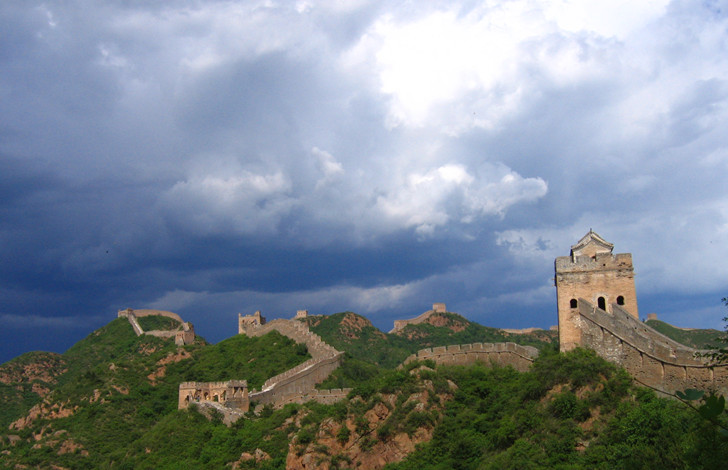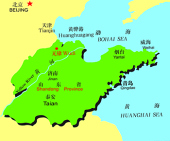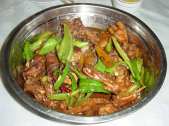
China Overview
- Population: 1.3 billion
- Currency: yuan
- Guinness World Records: most people painting each other's faces simultaneously in one location (13,413), largest bottle of cooking oil (containing 3212 litres), most couples hugging (3009 couples).
- Internet users: 135 million
- Milk beer: from Inner Mongolia, an alternative to the traditional mare's-milk wine.
- Squirrel fish: whole mandarin fish deep-fried and manipulated to resemble a squirrel.
- Number of chinese characters: over 56,000
Shandong Cuisine
 | Shandong cuisine, which is more commonly known as Lu cuisines, are one of the Eight Culinary Traditions of China, andis also ranked among the four most influential among these ("Four Great Traditions"). It is derived from the native cooking styles of Shandong, an eastern coastal province of China. |
| What are the two types of Shandong cuisine? Shandong cuisine consists of two major styles. Jiaodong style encompasses dishes from eastern Shandong like Fushan, Qingdao, Yantai and surrounding regions, characterized by seafood cooking, with light tastes. Jinan style includes dishes from Jinan, Dezhou, Tai'an and surrounding regions, famed for its soup and utilizing soups in its dishes. |
| What are the characteristics of Shandong cuisine? Shangdong cuisine is famous for its wide selection of material and use of different cooking methods. The raw materials are mainly domestic animals and birds, seafood and vegetables. The masterly cooking techniques include Bao (quick frying), Liu (quick frying with corn flour), Pa (stewing), roasting, |
|
boiling, using sugar to make fruit, crystallizing with honey.Its dishes are crisp, tender, delicious, and greasy with salty and some sweet and sour flavors. Its main condiment is salt, but it also uses salted fermented soybeans and soy sauce. | |
| What is the history of Shandong cuisine? Shandong cuisine can be traced back to the Spring and Autumn Period (770-221BC), when Shandong was territory of Qi and Lu. Both states were economically and culturally developed. Because they bordered the sea, and had mountains and fertile plains, they had abundant aquatic products and grains as well as sea salt. The people of the area have stressed seasonings and flavorings since ancient times. |
| Why does Shandong cuisine enjoy a great prestige? The cuisine is considered the most influential in Chinese cuisine, with the majority of the culinary styles in China having developed from it. Modern day schools of cuisine in North China, such as those of Beijing, Tianjin and Northeast, are all branches of the cuisine. Also, the typical dishes in most North China households' meals are prepared in simplified Shandong methods. |
 | What are the main ingredients used in Shandong Cuisine? Shandong is a large peninsula surrounded by the sea, with the Yellow River meandering through the center. As a result, seafood is a major component of the cuisine. The most famous dish is the sweet and sour carp. Beyond the use of seafood, Shandong is somewhat unique for its wide use of corn, a local cash crop, which is chewy and starchy,often with a grassy aroma. |
It is often served simply as steamed or boiled cobs, or removed from the cob and lightly fried. | |
Potatoes, tomatoes, cabbages, mushrooms, onions, garlic and eggplants make up the staple vegetables in the Shandong diet. Grassy greens, sea grasses, and bell peppers are also not uncommon. The large, sweet cabbages grown in central Shandong are renowned for their delicate flavor and hardiness. As has been the case for generations, these cabbages are a staple of the winter diet throughout much of the province, and are featured in a |
|
| great number of dishes.Possibly Shandong's greatest contribution to Chinese cuisine has been in the area of brewing vinegars. Hundreds of years of experience combined with unique local methods have led to Shandong's prominence as one of the premier regions for vinegar production in China. Shandong vinegar has a rich, complex flavor which, among some connoisseurs, is considered fine enough to be enjoyed on its own merits. | |
All Topics about China
- General-China-Introduction
- C2-Chinese-History
- Chinese-Religions
- Chinese-Food-and-Drink
- Chinese-Literature
- Chinese-Nationality
- Chinese-Architecture
- Chinese-Arts-and-Crafts
- Chinese-Language-and-Education
- Chinese-Medicine
- Chinese-Transportation
- Chinese-Festival
- Chinese-Astrology-and-Zodiac
- Chinese-Calendar
- Chinese-Traditional-Sports-&-Activities
- Chinese-Martial-Arts
HOTMost Popular Topics
Climate in China
Because of its size, China has great climatic diversity. Generally, the best time to visit China is during spring and autumn.
Chinese-Language-and-Education
Chinese is the most commonly used language in China, and one of the most commonly used languages in the world.
Chinese-Festival
China has many traditional festivals, including the Spring Festival, the Lantern Festival, the Dragon Boat Festival.
Chinese Chinese-Astrology-and-Zodiac
In the Chinese zodiac, twelve animals are used to denote the year of a person's birth: rat, ox, tiger, rabbit, dragon.
History of China
China, one of the world's most ancient civilizations, has a recorded history of nearly 4,000 years..
0813q.jpg)








